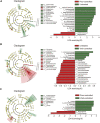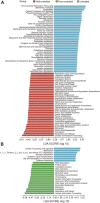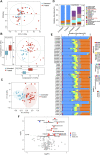Antihypertensive Therapy by ACEI/ARB Is Associated With Intestinal Flora Alterations and Metabolomic Profiles in Hypertensive Patients
- PMID: 35399511
- PMCID: PMC8986158
- DOI: 10.3389/fcell.2022.861829
Antihypertensive Therapy by ACEI/ARB Is Associated With Intestinal Flora Alterations and Metabolomic Profiles in Hypertensive Patients
Abstract
Angiotensin-converting enzyme inhibitors and angiotensin receptor blockers (ACEI/ARB) are the first-line drugs for the treatment of essential hypertension (HTN), one of the most important risk factors for cardiovascular and cerebrovascular diseases. Intestinal flora and microbial metabolites have been demonstrated to play important roles in blood pressure (BP) regulation and HTN development. However, it remains elusive that intestinal bacteria and metabolites are associated with the protective effects of ACEI/ARB anti-hypertensive drugs against HTN. In this study, we evaluated the effect of ACEI/ARB on gut microbiome and metabolites in patients suffering from HTN. We performed 16S rRNA sequencing and fecal metabolomic analysis of 36 HTN patients placed on ACEI/ARB therapy and 19 newly diagnosed HTN patients with no history of anti-hypertensive treatment. Patients under medication treatment were further classified into well-controlled (n = 24) and poor-controlled (n = 12) groups according to their BP levels. The ACEI/ARB improved the intestinal microbiome of the HTN patients by reducing potentially pathogenic bacteria such as Enterobacter and Klebsiella and increasing beneficial bacteria such as Odoribacter. Moreover, ACEI/ARB therapy was correlated with significant metabolomic changes in the HTN patients, including progressively enhanced inositol from poor-controlled to well-controlled groups. The profiles of gut bacteria were linked to the production of metabolites, and inositol was negatively correlated with Klebsiella, Enterobacter, and Proteobacteria. Our study suggests that ACEI/ARB modulates gut microbial composition and functions and alters microbial metabolites in HTN patients.
Keywords: ACEI/ARB; anti-hypertensive; hypertension; intestinal flora; metabolomics.
Copyright © 2022 Dong, Wang, Jiao, Yang, Chen and Li.
Conflict of interest statement
The authors declare that the research was conducted in the absence of any commercial or financial relationships that could be construed as a potential conflict of interest.
Figures







Similar articles
-
Intestinal microbiota by angiotensin receptor blocker therapy exerts protective effects against hypertensive damages.Imeta. 2024 Jul 18;3(4):e222. doi: 10.1002/imt2.222. eCollection 2024 Aug. Imeta. 2024. PMID: 39135690 Free PMC article.
-
Renin-angiotensin-aldosterone-system inhibition is safe in the preoperative period surrounding carotid endarterectomy.J Vasc Surg. 2016 Mar;63(3):715-21. doi: 10.1016/j.jvs.2015.09.048. Epub 2015 Nov 18. J Vasc Surg. 2016. PMID: 26603543
-
Combined angiotensin-converting enzyme inhibition and receptor blockade associate with increased risk of cardiovascular death in hemodialysis patients.Kidney Int. 2011 Nov;80(9):978-985. doi: 10.1038/ki.2011.228. Epub 2011 Jul 20. Kidney Int. 2011. PMID: 21775975 Free PMC article.
-
The use of renin-angiotensin-aldosterone system (RAAS) inhibitors is associated with a lower risk of mortality in hypertensive COVID-19 patients: A systematic review and meta-analysis.J Med Virol. 2021 Mar;93(3):1370-1377. doi: 10.1002/jmv.26625. Epub 2020 Nov 10. J Med Virol. 2021. PMID: 33095513
-
The Role and Mechanism of Intestinal Flora in Blood Pressure Regulation and Hypertension Development.Antioxid Redox Signal. 2021 Apr 1;34(10):811-830. doi: 10.1089/ars.2020.8104. Epub 2020 May 14. Antioxid Redox Signal. 2021. PMID: 32316741 Review.
Cited by
-
Gut Dysbiosis and Cardiovascular Health: A Comprehensive Review of Mechanisms and Therapeutic Potential.Cureus. 2024 Aug 16;16(8):e67010. doi: 10.7759/cureus.67010. eCollection 2024 Aug. Cureus. 2024. PMID: 39280497 Free PMC article. Review.
-
Intestinal microbiota by angiotensin receptor blocker therapy exerts protective effects against hypertensive damages.Imeta. 2024 Jul 18;3(4):e222. doi: 10.1002/imt2.222. eCollection 2024 Aug. Imeta. 2024. PMID: 39135690 Free PMC article.
-
Protein-bound uremic toxins as therapeutic targets for cardiovascular, kidney, and metabolic disorders.Front Endocrinol (Lausanne). 2025 Jan 27;16:1500336. doi: 10.3389/fendo.2025.1500336. eCollection 2025. Front Endocrinol (Lausanne). 2025. PMID: 39931238 Free PMC article. Review.
-
Visceral adiposity in postmenopausal women is associated with a pro-inflammatory gut microbiome and immunogenic metabolic endotoxemia.Microbiome. 2024 Oct 4;12(1):192. doi: 10.1186/s40168-024-01901-1. Microbiome. 2024. PMID: 39367431 Free PMC article.
-
Association of probiotic supplementation and cardiovascular risk profiles of patients with coronary artery disease-a cross-sectional analysis of the NHANES database between 1999-2019.Front Nutr. 2025 Feb 28;12:1495633. doi: 10.3389/fnut.2025.1495633. eCollection 2025. Front Nutr. 2025. PMID: 40093880 Free PMC article.
References
LinkOut - more resources
Full Text Sources

